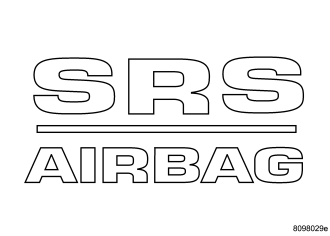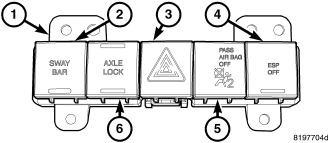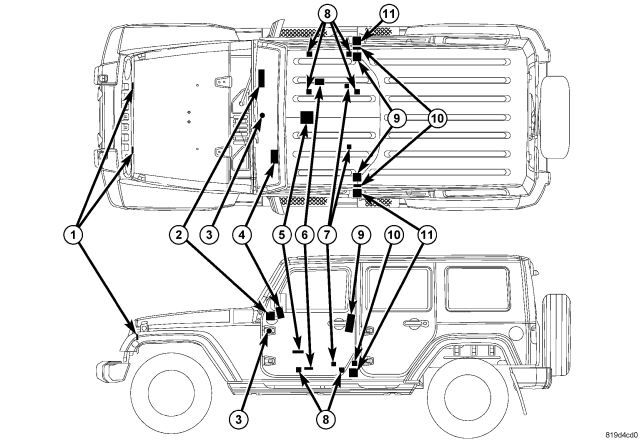DESCRIPTION
An occupant restraint system is standard factory-installed safety equipment on this vehicle. Available occupant restraints for this vehicle include both active and passive types. Active restraints
are those which require the vehicle occupants to take some action to employ, such as fastening a seat belt; while passive restraints require no action by the vehicle occupants to be employed.
ACTIVE RESTRAINTS
The active restraints for this vehicle include:
-
Child Restraint Anchors - All two-door vehicles are equipped with two, fixed-position, child seat upper tether anchors for the second row seating. The two upper tether anchors are
integral to the back of the seat cushion frame. All four-door vehicles are equipped with three, fixed-position, child seat upper tether anchors for the second row seating. A single upper tether anchor is
integral to the back of the left seat cushion frame, and two more are integral to the back of the right cushion frame. Two lower anchors are provided for each outboard second row seating position on both
two-door and four-door vehicles. The lower anchors are integral to the seat cushion frame on two-door vehicles. The lower inboard anchors are integral to the seat back panels of four-door vehicles, while
the lower outboard anchors are integral to the seat back hinge brackets. All lower anchors are accessed from the front of the second row seat where the seat back meets the seat cushion.
-
Front Seat Belts - Both front seating positions are equipped with three-point seat belt systems employing a lower B-pillar mounted inertia latch-type emergency locking retractors,
height-adjustable upper sport bar (two-door) or B-pillar (four-door) mounted turning loops and a traveling end-release seat belt buckle secured to the inboard side of the seat frame. A traveling lower seat
belt anchor is secured to the outboard side of the seat frame on all vehicles except for the driver side of two-door vehicles manufactured for sale in domestic markets, which has a fixed lower seat belt
anchor secured to the base of the B-pillar. The driver side front seat belt buckle includes an integral seat belt switch that detects whether the driver side front seat belt has been fastened.
-
Second Row Seat Belts - All second row seating positions are equipped with three-point seat belt systems. The outboard seating position belts employ lower sport bar mounted inertia
latch-type emergency locking retractors, fixed position upper sport bar mounted turning loops and fixed lower seat belt anchors secured to the rear floor panel. The second row seat center seating position
of four-door vehicles has an inertia latch-type emergency locking retractor that is secured within the right seat back panel and a lower anchor secured to the rear floor panel along with the right outboard
buckle. All of the second row seat belt retractors for this vehicle are also switchable from an emergency locking retractor to an automatic locking retractor for compatibility with child seats. The center
seating position and left outboard buckles are secured to the seat back hinge bracket. All second row seat belts have fixed end-release seat belt buckles.
PASSIVE RESTRAINTS

The passive restraints available for this vehicle include the following:

-
Dual Front Airbags - Multistage driver and front passenger airbags are used in this vehicle. This airbag system is a passive, inflatable, Supplemental Restraint System (SRS) and
vehicles with this equipment can be readily identified by the SRS - AIRBAG logo molded into the driver airbag trim cover in the center of the steering wheel and also into the passenger airbag
door on the instrument panel above the glove box. Vehicles with the airbag system can also be identified by the airbag indicator, which will illuminate in the ElectroMechanical Instrument Cluster (EMIC)
(also known as the Cab Compartment Node/CCN) for about seven seconds as a bulb test each time the ignition switch is turned to the ON position. A pyrotechnic-type seat belt tensioner is also integral to
the front seat belt retractors mounted on the lower inner B-pillars to work in conjunction with the dual front airbags.
-
Occupant Classification System - Vehicles manufactured for sale in North America also include an Occupant Classification System (OCS) with components that are located on the front
seats. These components include an Occupant Classification Module (OCM) and four seat weight sensors on the passenger seat, and seat track position sensors on both the driver and passenger front seats.
Vehicles equipped with the OCS components can be readily identified by a passenger airbag on/off indicator (5) located to the right of the hazard switch button in the instrument panel switch pod (1) near
the base of the instrument panel center bezel.
-
Seat Airbags - Seat mounted airbags are optional equipment in this vehicle. This airbag system is a passive, inflatable, Supplemental Restraint System (SRS) and vehicles with this
equipment can be readily identified by a sewn tag with the SRS - AIRBAG logo located on the outboard side of the front seat back trim cover.

The supplemental restraint system includes the following major components, which are described in further detail elsewhere in this service information:
-
Airbag Indicator - The airbag indicator is integral to the ElectroMechanical Instrument Cluster (EMIC) (also known as the Cab Compartment Node/CCN), which is located on the instrument
panel in front of the driver.
-
Clockspring - The clockspring is located near the top of the steering column, directly beneath the steering wheel.
-
Driver Airbag (4) - The driver airbag is located in the center of the steering wheel, beneath the driver airbag trim cover.
-
Driver Knee Blocker - The driver knee blocker is a structural unit secured to the back side of and integral to the instrument panel steering column opening cover.
-
Front Impact Sensor (1) - Two front impact sensors are used on vehicles equipped with dual front airbags, one left side and one right side. One sensor is located on the back side
of the front end module carrier on either side of the radiator and inboard of the headlamp within the engine compartment.
-
Occupant Classification Module (6) - Vehicles equipped with the Occupant Classification System (OCS) include an Occupant Classification Module (OCM) which is secured to a bracket
on the inboard side of the inboard passenger side seat track riser beneath the seat cushion.
-
Occupant Restraint Controller (5) - The Occupant Restraint Controller (ORC) is located on a mount on the floor panel transmission tunnel rearward of the transmission gear selector,
and is concealed beneath the center floor console.
-
Passenger Airbag (2) - The passenger airbag is located in the instrument panel, beneath the passenger airbag door on the instrument panel above the glove box on the passenger side
of the vehicle.
-
Passenger Airbag On/Off Indicator (3) - Vehicles with the Occupant Classification System (OCS) include a passenger airbag on/off indicator which is located in the instrument panel
switch pod near the base of the instrument panel lower center bezel.
-
Passenger Knee Blocker - The passenger knee blocker is a structural reinforcement that is integral to and concealed within the glove box door.
-
Seat Airbag (9) - An optional seat airbag unit is secured to each outboard front seat back frame, where it is concealed beneath the seat back trim cover and foam.
-
Seat Belt Tensioner (11) - A seat belt tensioner is integral to both front seat belt retractor units on vehicles equipped with dual front airbags. The seat belt retractor tensioner
units are secured to each lower inner B-pillar and are concealed behind the lower B-pillar trim.
-
Seat Track Position Sensor (7) - Two seat track position sensors are standard equipment in this vehicle. One sensor is located on the inboard side of one of the seat adjuster tracks
on both the driver and the passenger side front seats.
-
Seat Weight Sensor (8) - Vehicles equipped with the Occupant Classification System (OCS) include four seat weight sensors, one on each corner of the passenger side front seat between
the lower seat adjuster tracks and the seat track risers.
-
Side Impact Sensor (10) - Two side impact sensors are used on vehicles equipped with the optional seat airbags, one on each side of the vehicle. One sensor is located behind the
B-pillar trim near the belt line of each B-pillar.
The ORC, the OCM, and the EMIC each contain a microprocessor and programming that allow them to communicate with each other using the Controller Area Network (CAN) data bus. This method of communication
is used by the ORC for control of the airbag indicator in the EMIC.
(Refer to 8 - ELECTRICAL/ELECTRONIC CONTROL MODULES/COMMUNICATION - DESCRIPTION).
Hard wired circuitry connects the supplemental restraint system components to each other through the electrical system of the vehicle. These hard wired circuits are integral to several wire
harnesses, which are routed throughout the vehicle and retained by many different methods. These circuits may be connected to each other, to the vehicle electrical system, and to the supplemental restraint
system components through the use of a combination of soldered splices, splice block connectors, and many different types of wire harness terminal connectors and insulators. Refer to the appropriate wiring
information. The wiring information includes wiring diagrams, proper wire and connector repair procedures, further details on wire harness routing and retention, as well as pin-out and location views for
the various wire harness connectors, splices and grounds.



